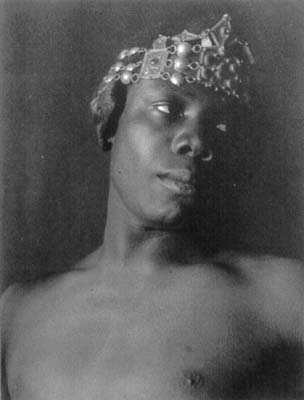July 8, 2011 /
Photography News/ Born 147 years ago, on July 8, 186, F. Holland Day was a dedicated aesthete and well-known figure in turn-of-the-century Boston. He was one of the earliest advocates of Pictorial photography in America and, like Alfred Stieglitz (with whom he corresponded until they had a serious disagreement around 1902), he tirelessly wrote articles, mounted exhibitions, and encouraged like-minded photographers who supported the medium’s artistic potential.
 |
| ‘Youth sitting on a stone”, 1907, F. Holland Day. Model is the Italian Nicola Giancola. |
Day’s life and works had long been controversial, since his photographic subjects were often nude male youths. Pam Roberts, in F. Holland Day (Waanders Pub, 2001; catalog of a Day exhibition at the Van Gogh Museum) writes: “Day never married and his sexual orientation, whilst it is widely assumed that he was homosexual, because of his interests, his photographic subject matter, his general flamboyant demeanor, was, like much else about him, a very private matter.”
 |
| Male nude, F. Holland Day. Source: Scan from the book ”Suffering the ideal”. |
Day spent much time among poor immigrant children in Boston, tutoring them in reading and mentoring them. One in particular, the 13-year-old Lebanese immigrant Kahlil Gibran, went on to fame as the author of The Prophet.
 |
| Kahlil Gibran in Middle Eastern costume with leopard skin and staff, seated, ca. 1898, F. Holland Day. 1 photographic print on 2 mounts: platinum print. Forms part of the Louise Imogen Guiney Collection. Anonymous gift to the Library of Congress, 1934. |
Probably his best-known work is an 1898 series of more than 250 photographs portraying the Passion of Christ, in which he posed as Jesus, training for the role by losing weight and letting his hair and beard grow. What is usually shown from this series is the group known as “The Seven Last Words of Christ,” seven portraits that refer to Jesus’ statements from the time of his crucifixion until his death. In each photograph Mr. Day, in character, assumed what he felt were facial expressions consonant with Jesus’ ordeal.
 |
| The Last Seven Words of Christ, 1898, F. Holland Day |
Day often made only a single print from a negative. He used only the platinum process, being unsatisfied with any other, and lost interest in photography when platinum became unobtainable following the Russian Revolution.F. Holland Day died on November 12, 1933.
Since the 1990s Day’s works have been included in major exhibitions by museum curators, notably in the solo Day retrospective at the Boston Museum of Fine Arts in 2000/2001 and similar shows at the Royal Photographic Society in England and the Fuller Museum of Art. Art historians are once again taking an interest in Day, and there are now significant academic texts on Day’s homoerotic portraiture, and its similarities to the work of Walter Pater and Thomas Eakins.
Day’s house at 93 Day Street, Norwood, Massachusetts is now a museum (The F. Holland Day House & Norwood History Museum), and the headquarters of the Norwood Historical Society.
 |
| Saint Sebastian, 1906, F. Holland Day |
 |
| Beauty is Truth, Truth is Beauty, 1898, F. Holland Day |
 |
| Black man with diadema, ca. 1897, F. Holland Day |
 |
| No title, ca. 1900, F. Holland Day |
 |
| Male nude, F. Holland Day. Source: Scan from the book Suffering the ideal. |
 |
| Tony Costanza in sailor suit, seated, leaning on pillows, 1911, F. Holland Day |
 |
| Portrait of Edward Carpenter, the early gay rights activist, F. Holland Day |
 |
| Amercian poet and essayist Louise Imogen Guiney (1861-1920) in Saint Barbara costume with laurel wreath, pearls, book and (pencilled-in) halo, 1893, F. Holland Day |
 |
| Woman (Julia Arthur) in Middle Eastern (Salome?) costume, ca. 1895, F. Holland Day |












